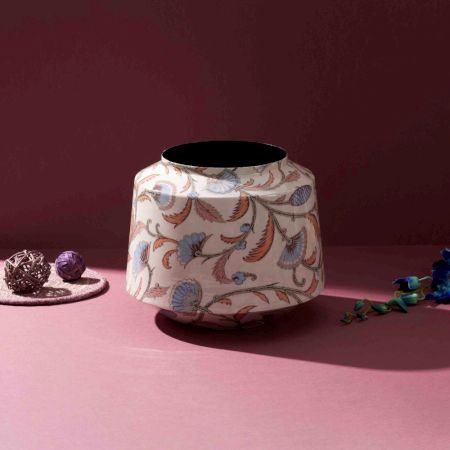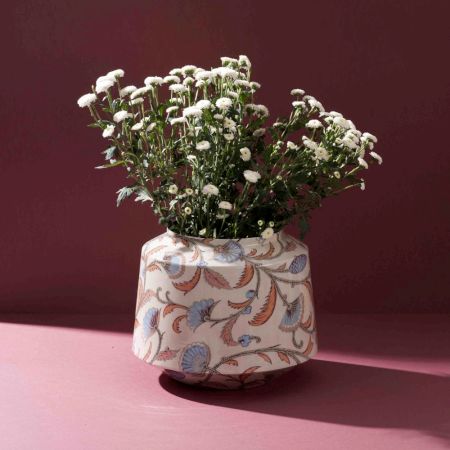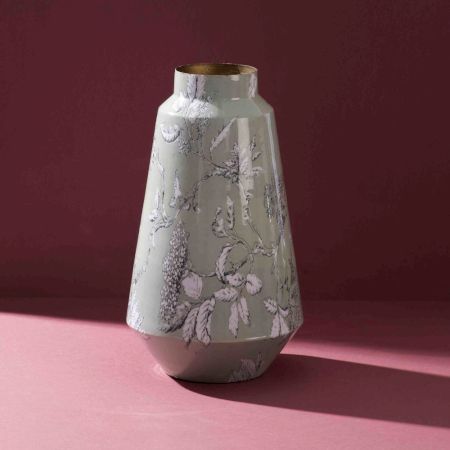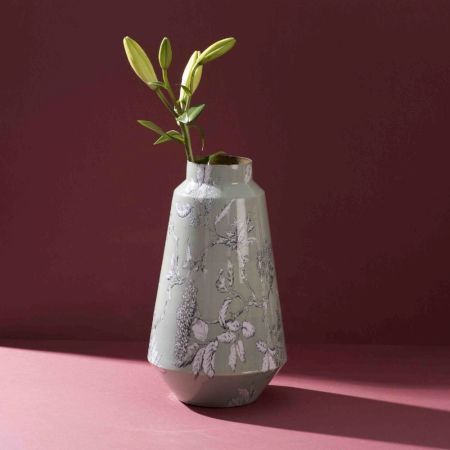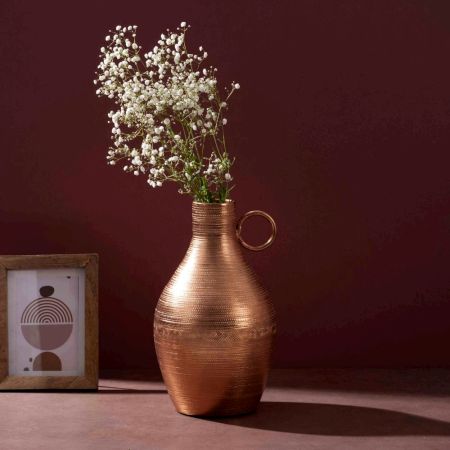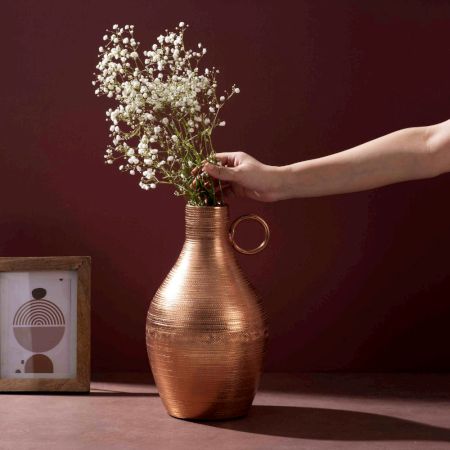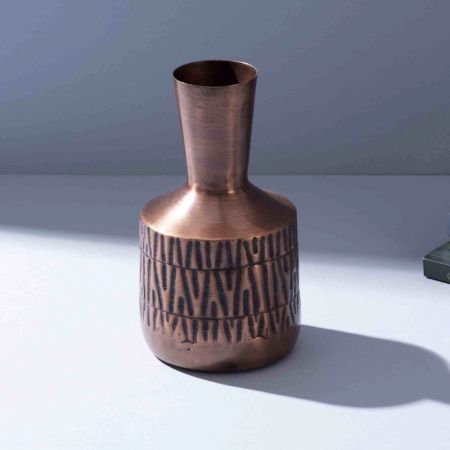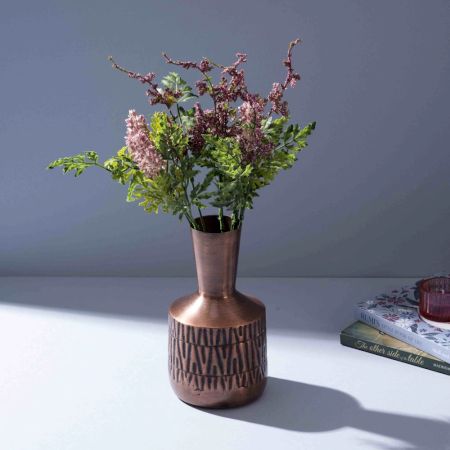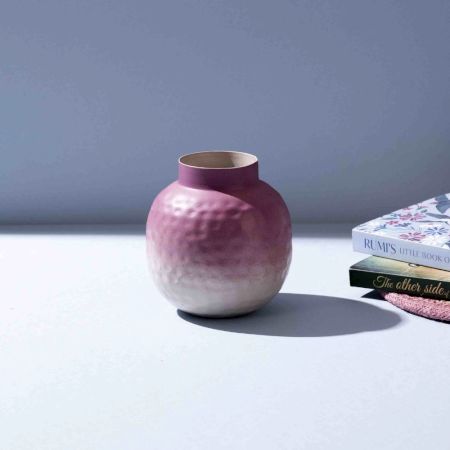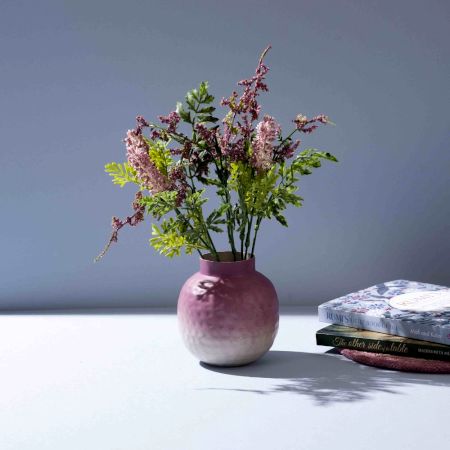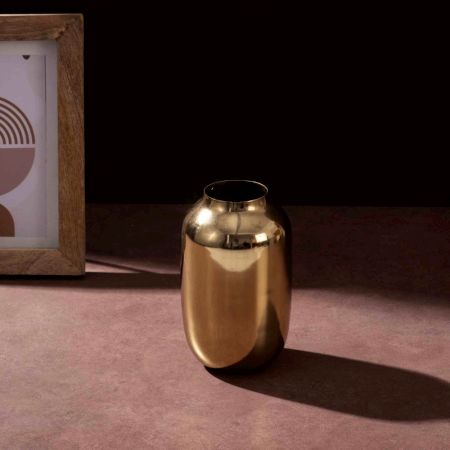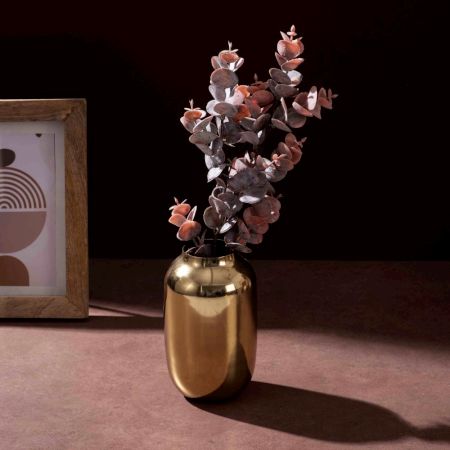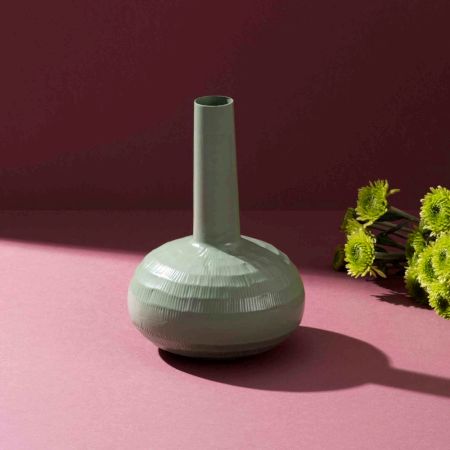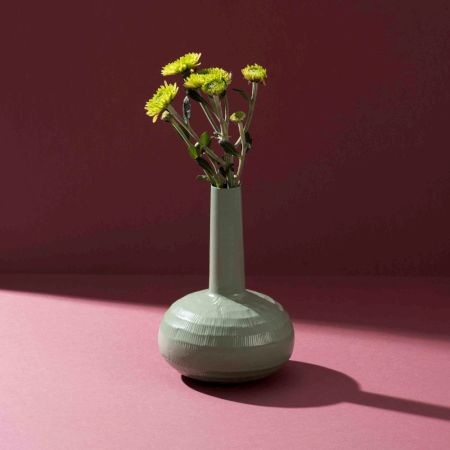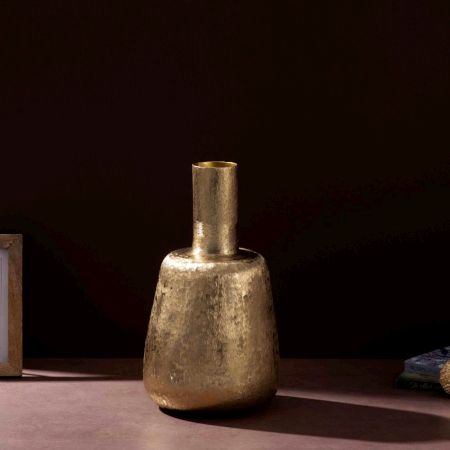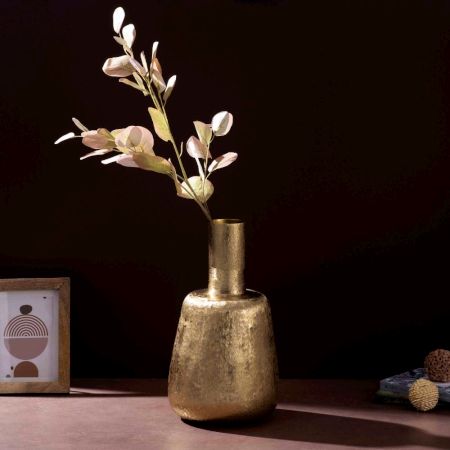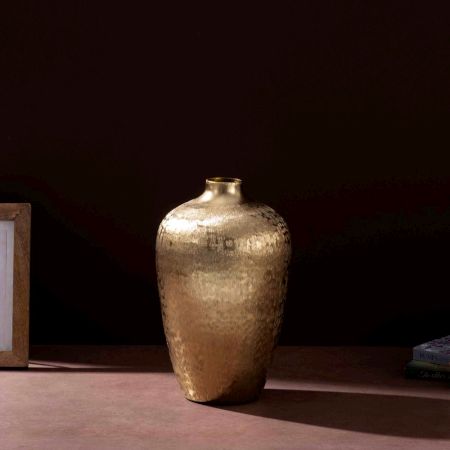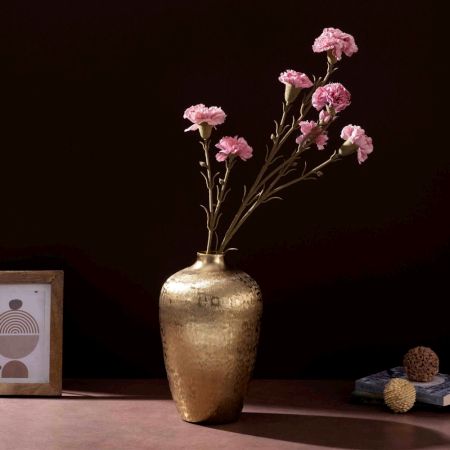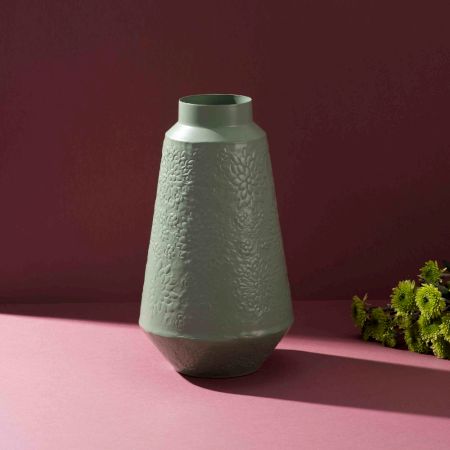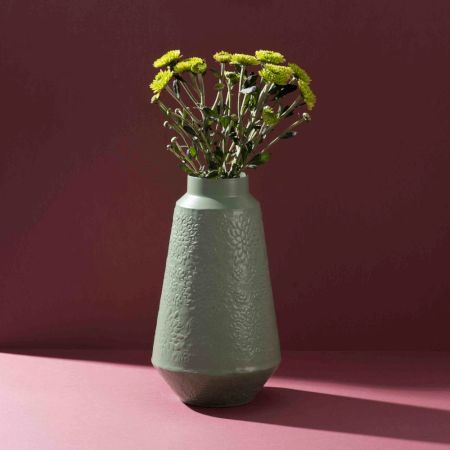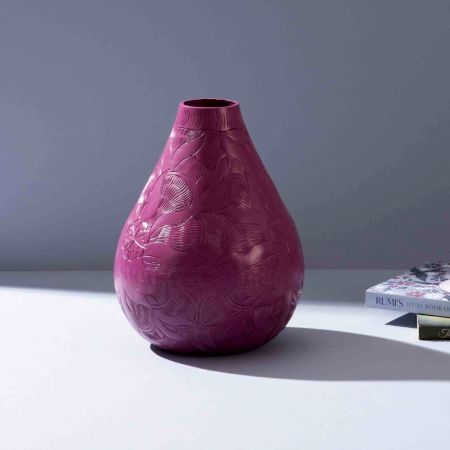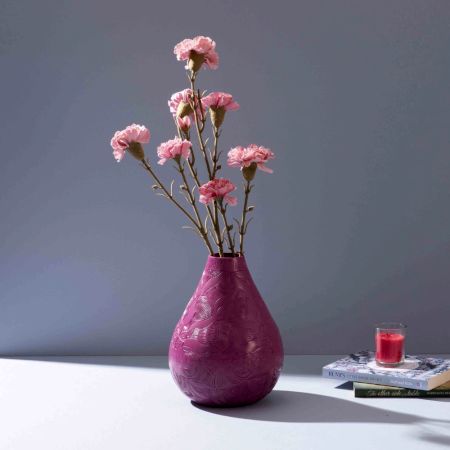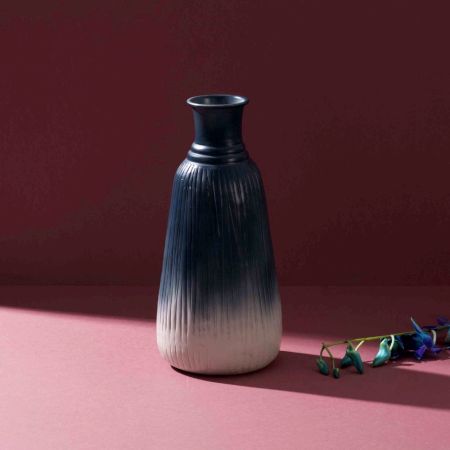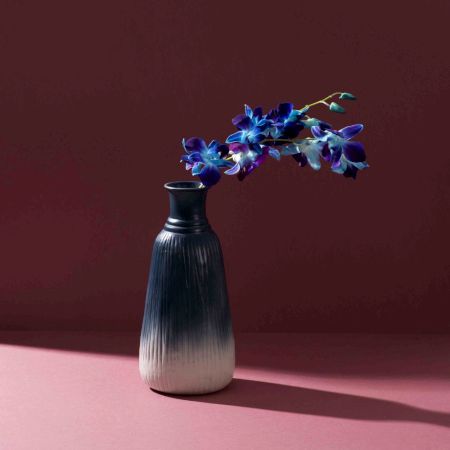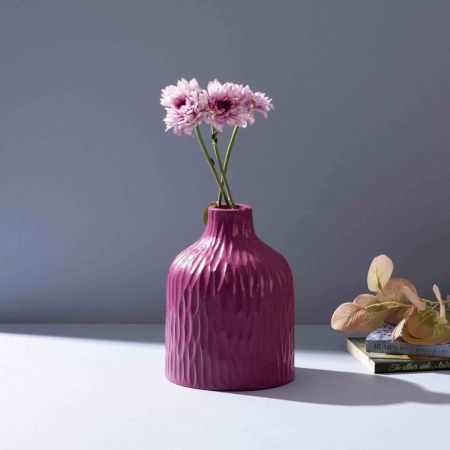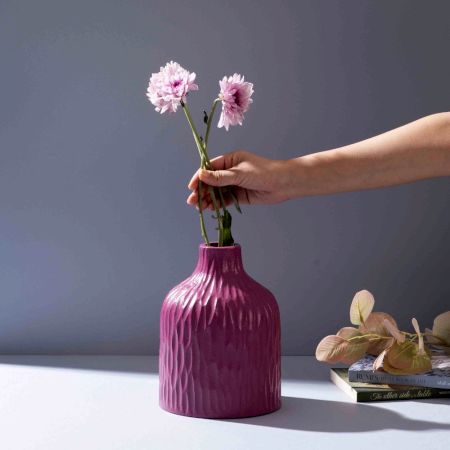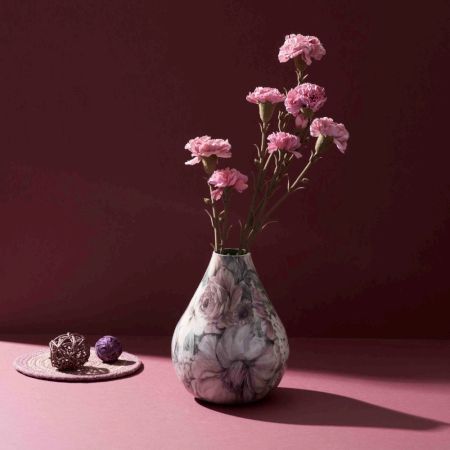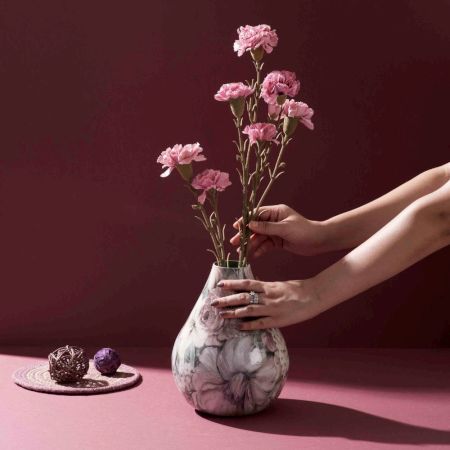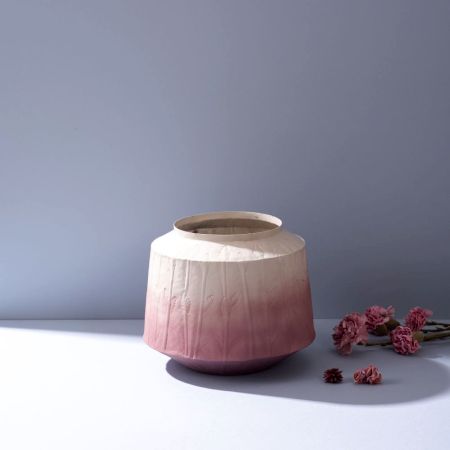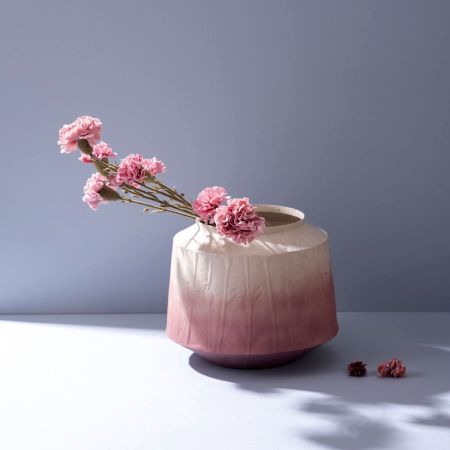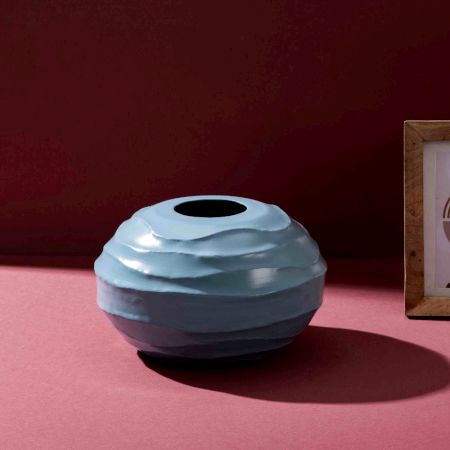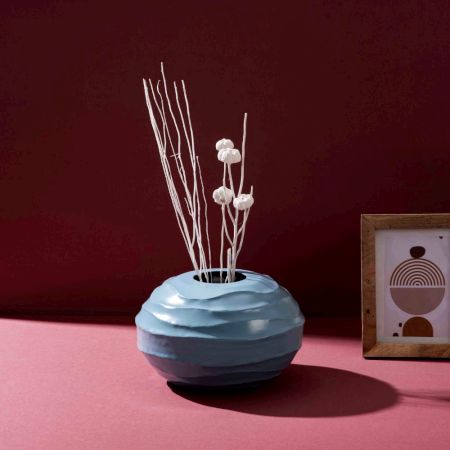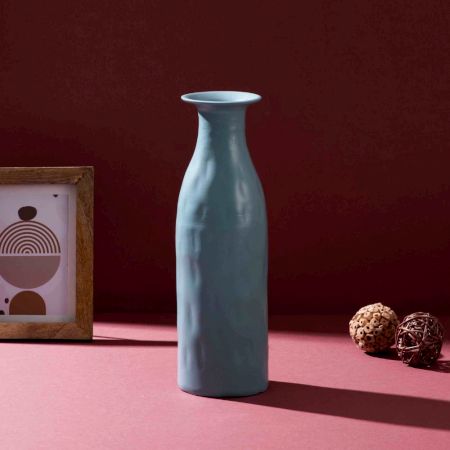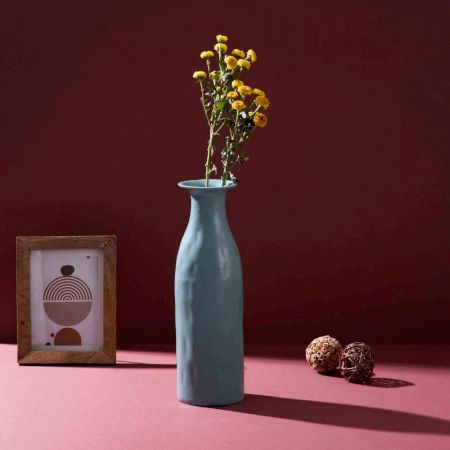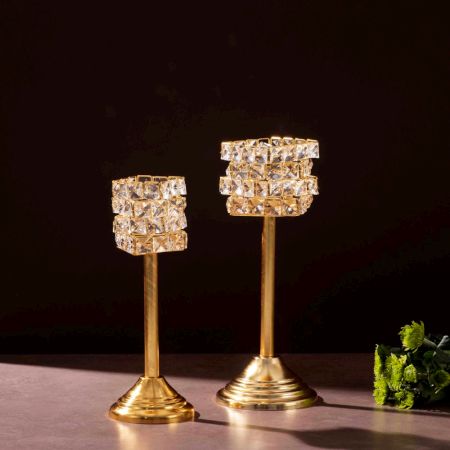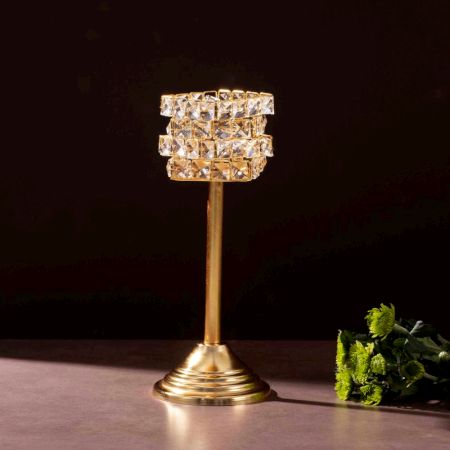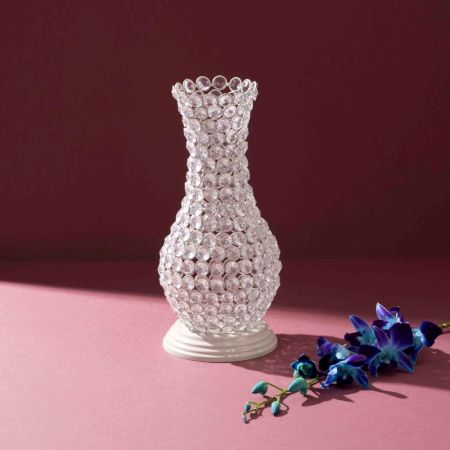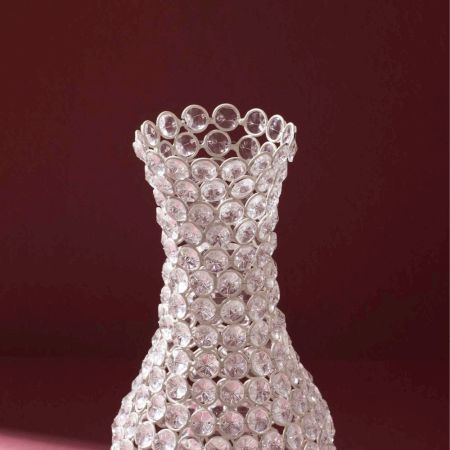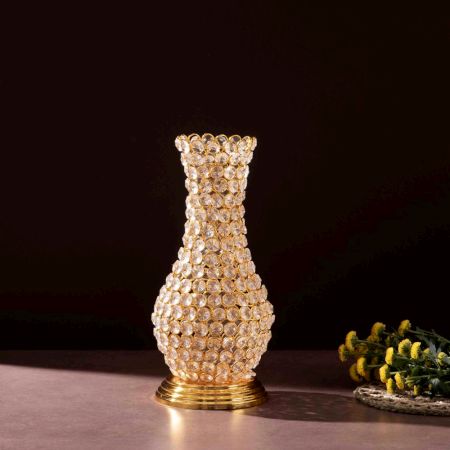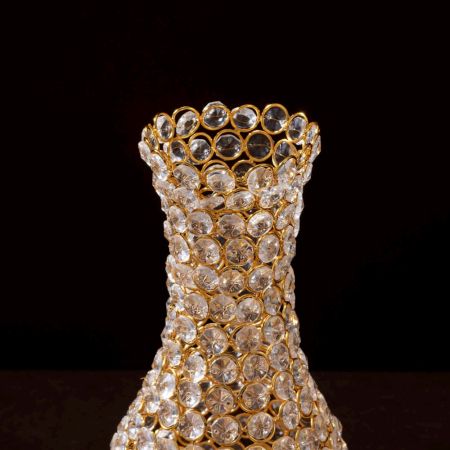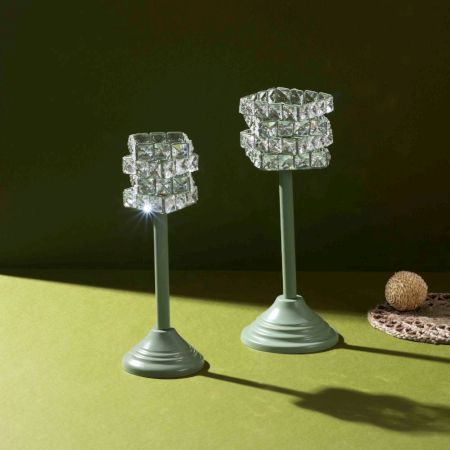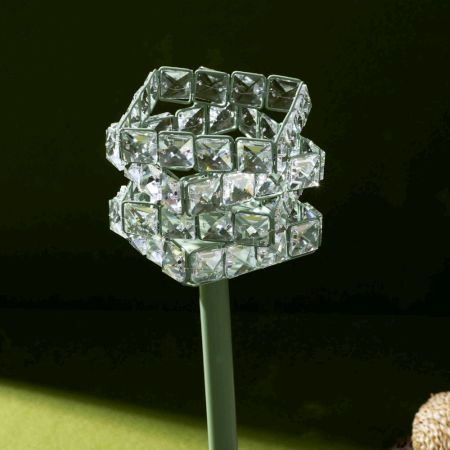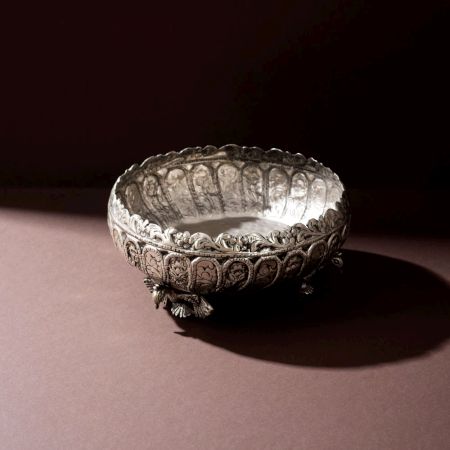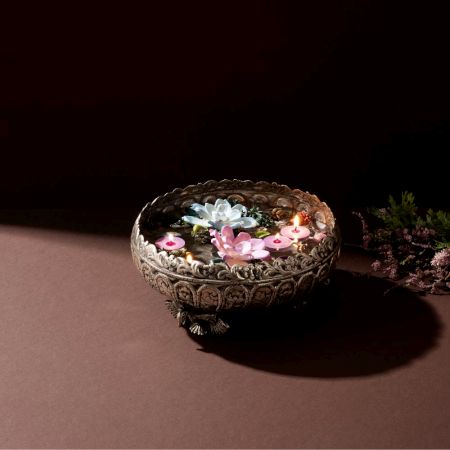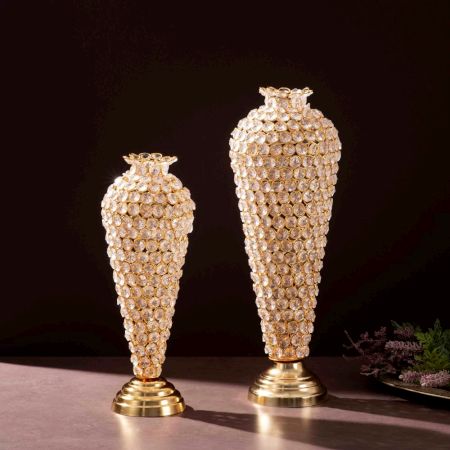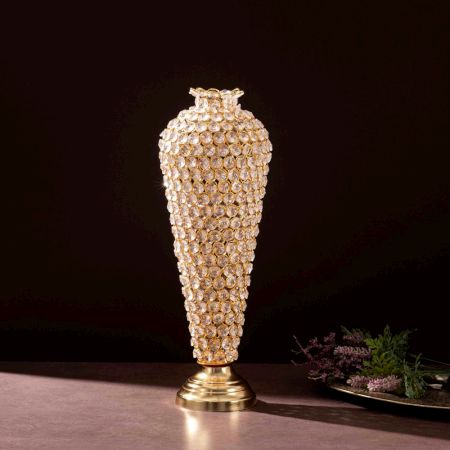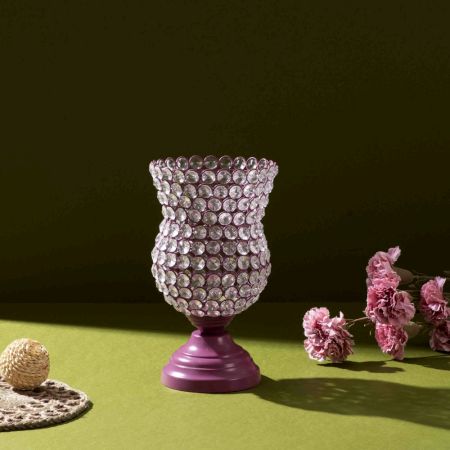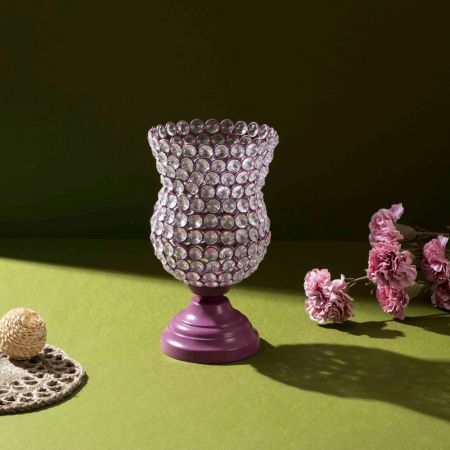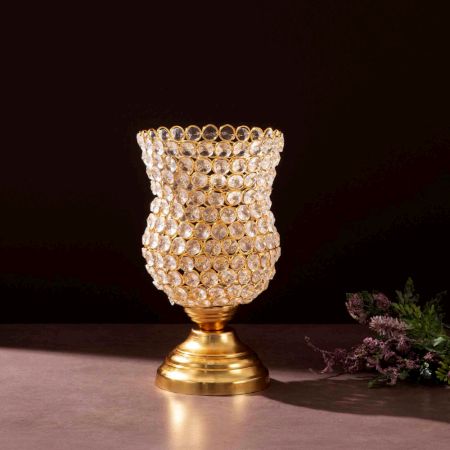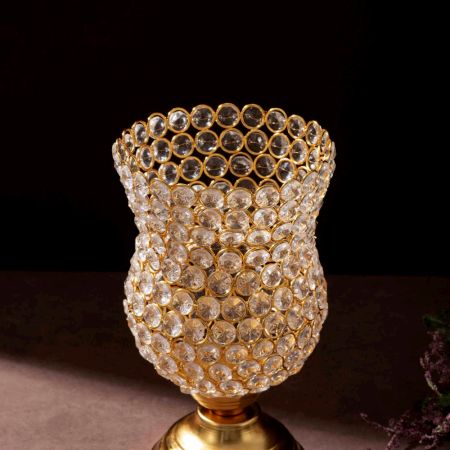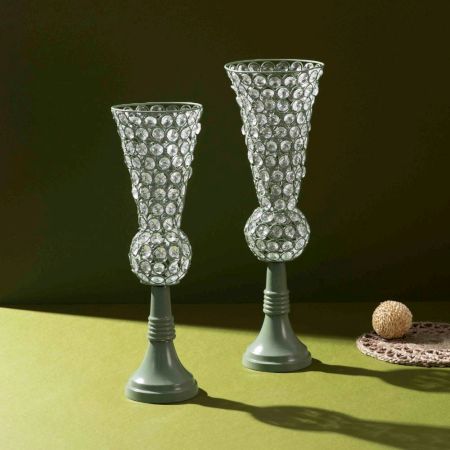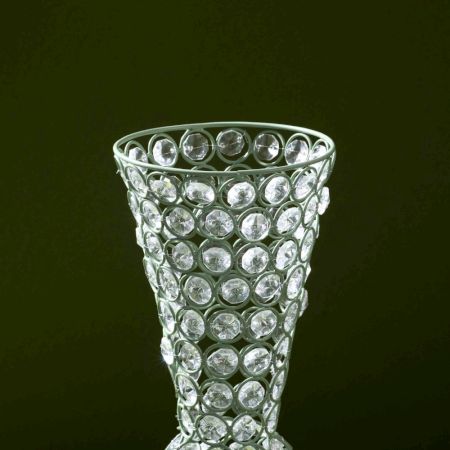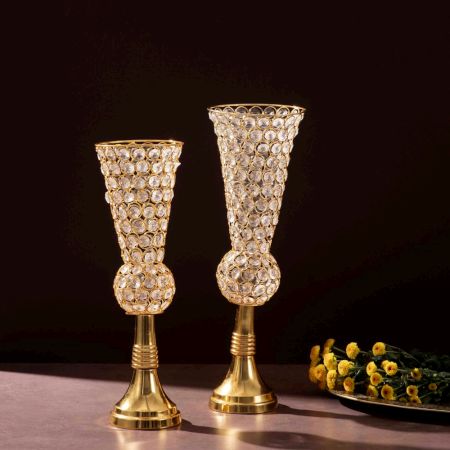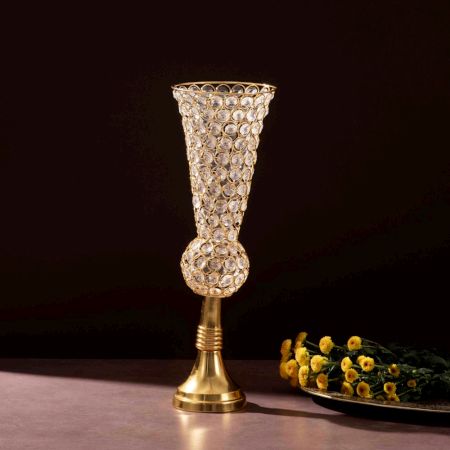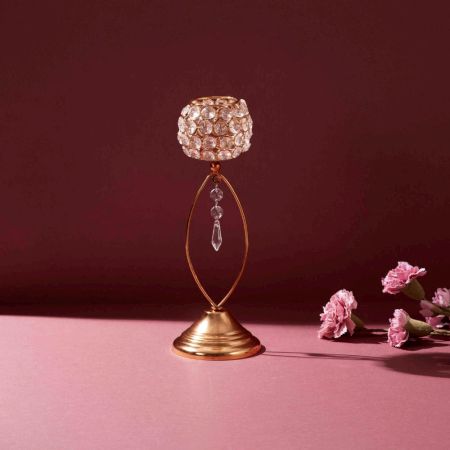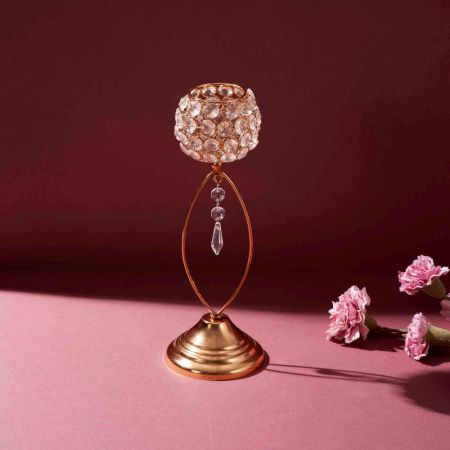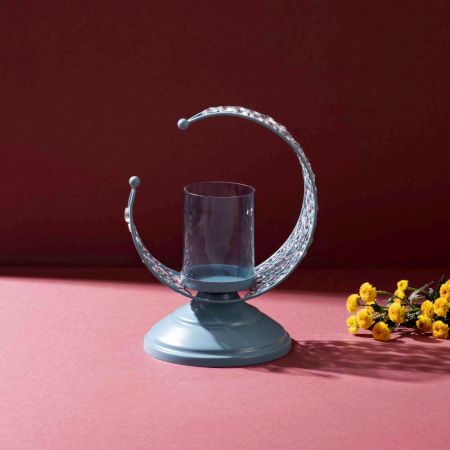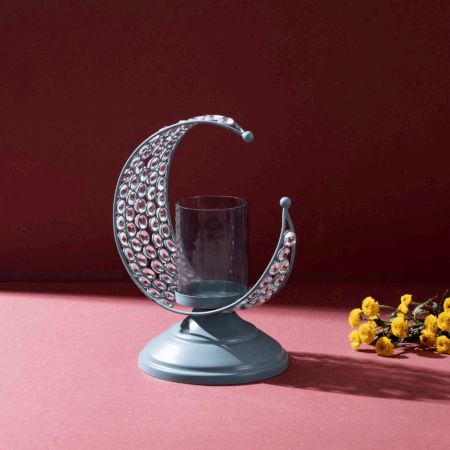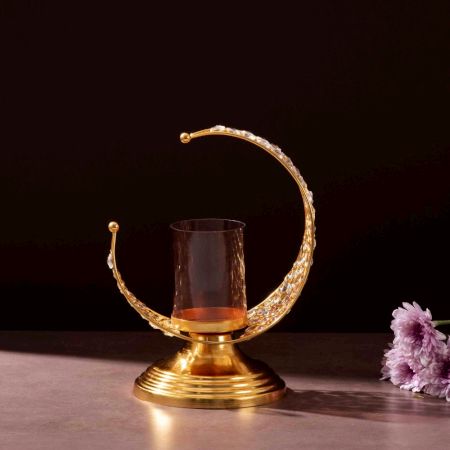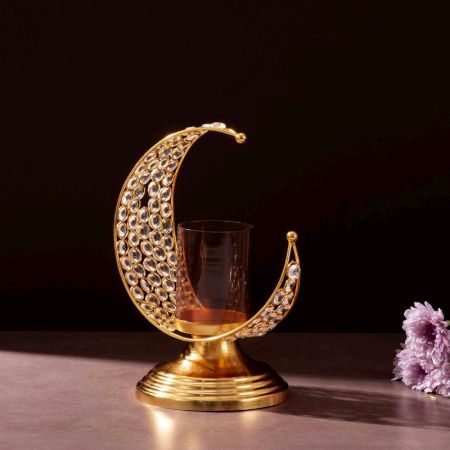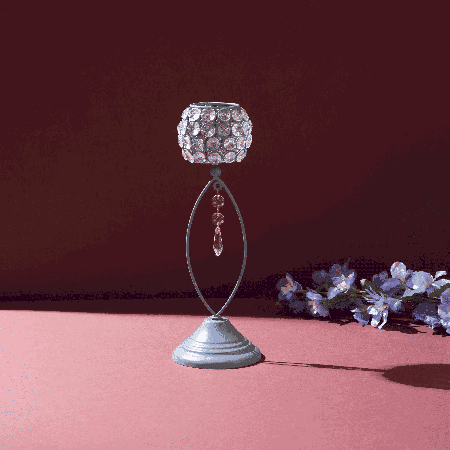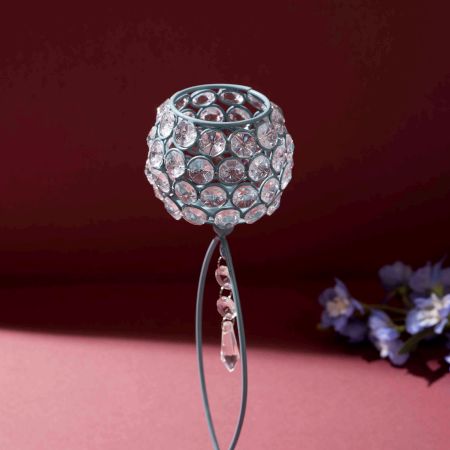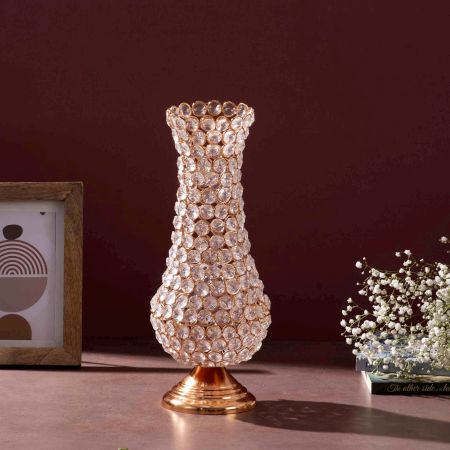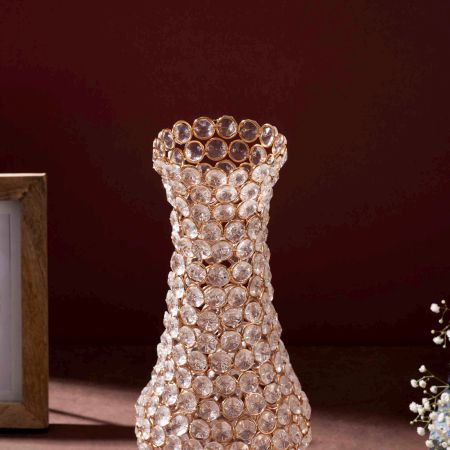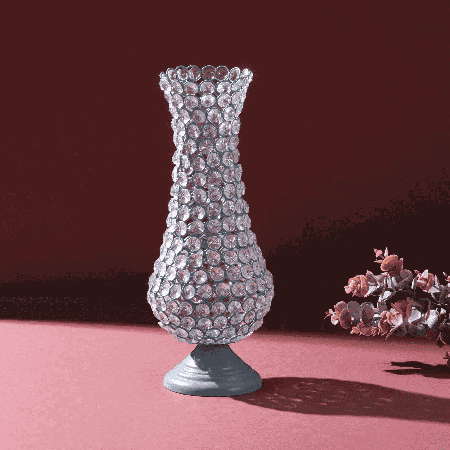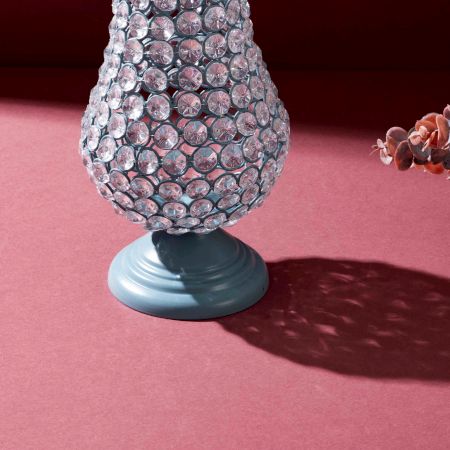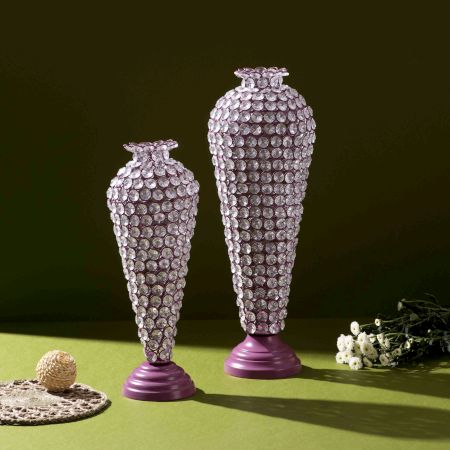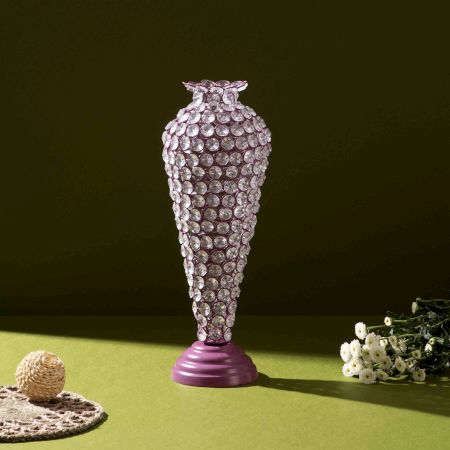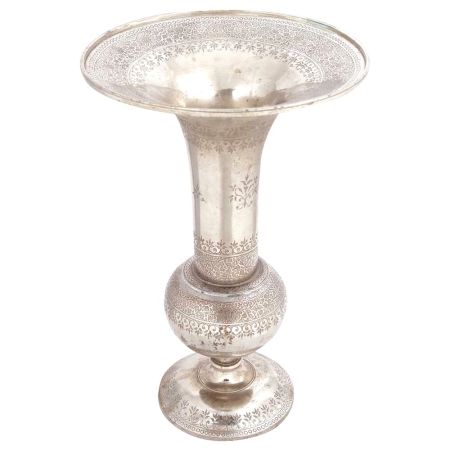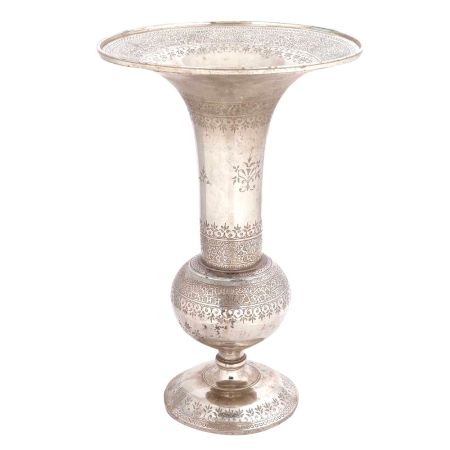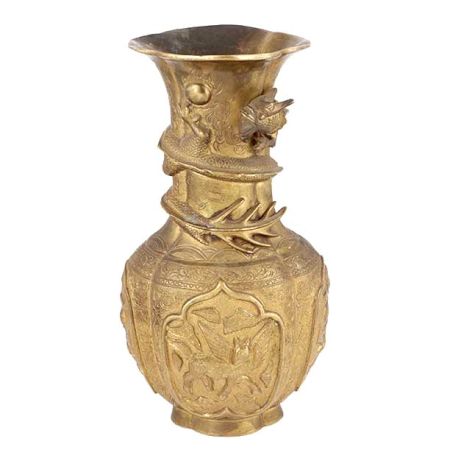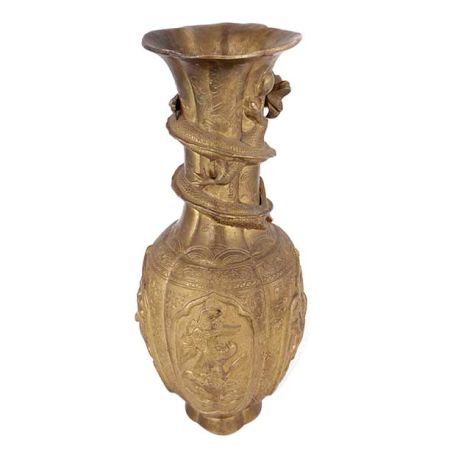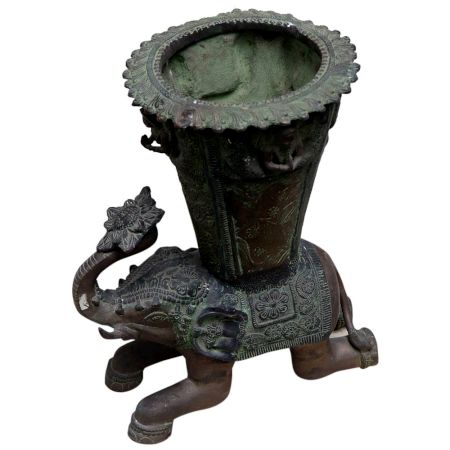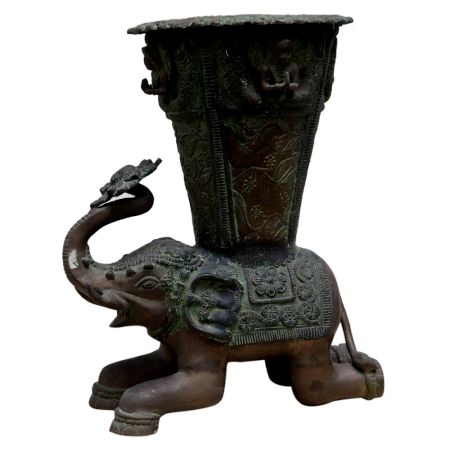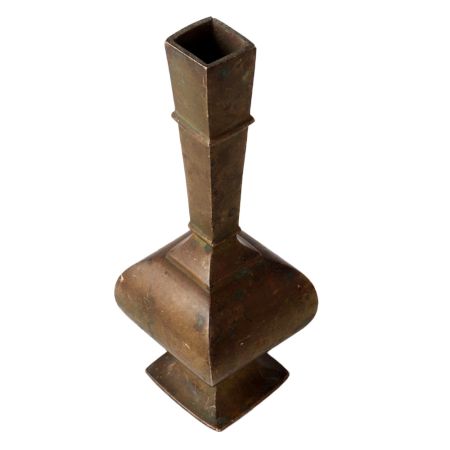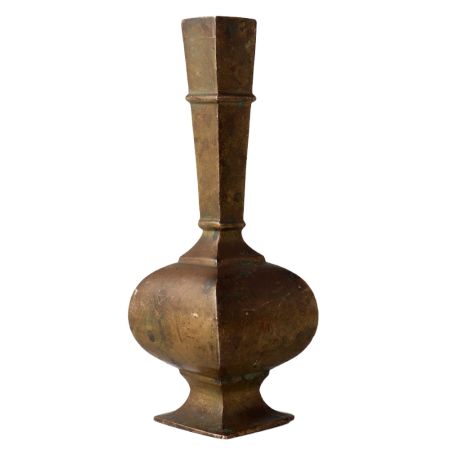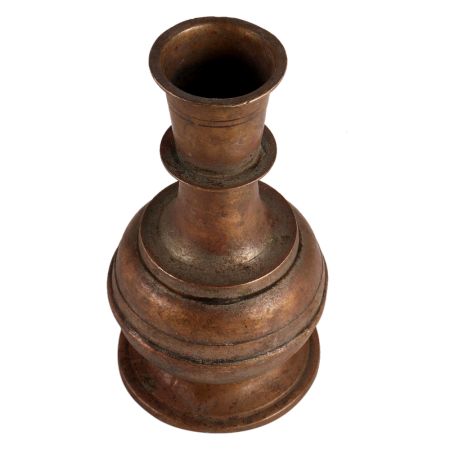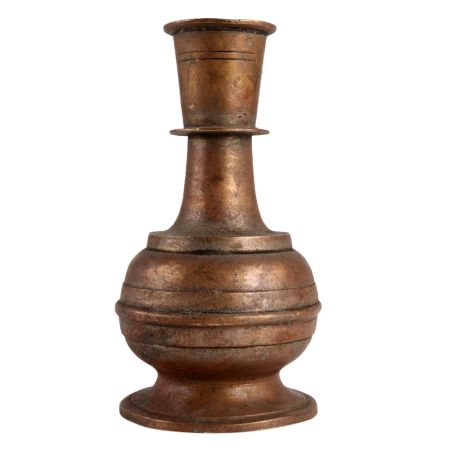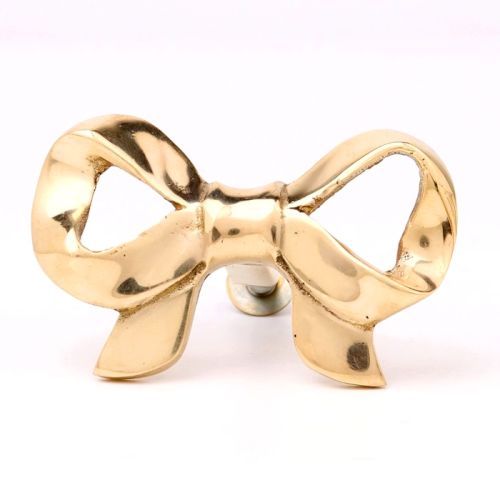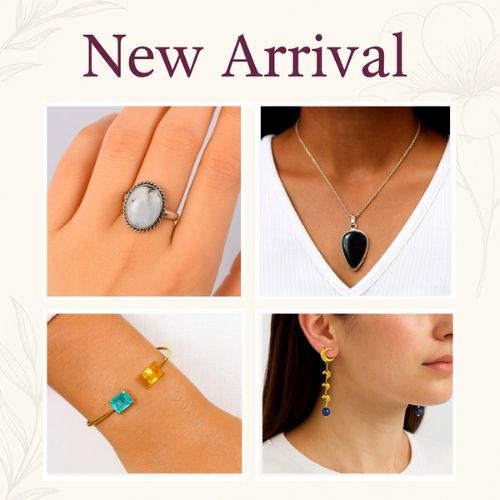-
Black Brass Urn Flower Vase Birds Engraved Pattern With Swirl Peacock Handles
- ₹ 23,500.00
-
Only a few left
General Understanding of Vases and Pen Stands
Vintage vases and pen stands are more than objects of utility. They belong to a period that carries cultural memory, often between 20 to 100 years old. What defines their vintage quality is not just age but the preserved design language such as floral engravings, colonial lines, or mid-century simplicity. Unlike purely antique pieces, they remain relatable in their form and function. A brass vase with subtle patina or a teakwood pen stand with inlaid motifs reflects the charm of bygone artistry while still being usable in today’s interiors.
A vase or pen stand is considered vintage when it combines historical lineage with visible craftsmanship. Unlike contemporary designs, these pieces often showcase time-tested materials such as brass, rosewood, or hand-blown glass. Their value lies in the way they carry signs of age such as tarnished polish, softened edges, or faded glaze that tell stories of use and continuity. Cultural anchors play a role too. A Mughal inspired floral vase is considered vintage because it preserves motifs from a courtly past. Similarly, a colonial era pen stand carved with gothic arches embodies a specific stylistic moment. What makes them treasured today is the balance of functionality and memory. They are not museum relics but living objects that resonate with heritage while retaining everyday relevance.
What Emotions Or Themes Do Vintage Vases And Pen Stands Commonly Reflect?
Vintage decor often carries emotions of nostalgia, permanence, and rootedness. A ceramic vase with hand painted lilies may reflect tenderness, while a brass pen stand with geometric engraving speaks of discipline and order. Themes vary across cultures. Indian designs often evoke spirituality and prosperity, while European styles lean toward refinement and elegance.
The emotional spectrum tied to vintage vases and pen stands is deeply layered. They often embody remembrance, objects that once sat on a scholar’s desk or adorned a family’s prayer room. A pen stand carved with lotuses could symbolize purity in Indian tradition, while a crystal vase from the Art Deco era reflects aspiration and progress. These pieces often carry themes of continuity, bridging generations through design. At times, they inspire intimacy, the way a floral ceramic vase can soften a room, or authority, as seen in the stern presence of colonial wooden pen stands. In both forms, emotion flows through material, design, and cultural association.
What Are The Most Recognized Styles In Vintage Vases And Pen Stands?
Styles in vintage decor reflect shifting aesthetics across history. Art Deco pieces with bold lines and symmetry embodied modernity. Colonial pen stands often used hardwood with structured forms, emphasizing order and discipline. Mughal vases were intricate, adorned with floral arabesques and motifs of paradise. Mid-century designs embraced minimalism with clean shapes and functionality. Each style stands as a time capsule of cultural aspirations and artistic choices.
The most recognized styles offer a visual map of heritage. Art Deco vases often seen in glass or ceramic mirror the optimism of the early 20th century with sharp geometry and metallic accents. Colonial pen stands highlight imperial influences, mahogany or teak carved in straight, formal lines that conveyed authority. Mughal vases by contrast bloom with vegetal motifs and enamel work reflecting spiritual abundance. Mid-century modern stands redefined function with sleek silhouettes rejecting ornamentation for utility. These styles remain iconic because they express cultural shifts from empire to independence, from ornament to simplicity. Together they form a design lexicon that collectors and homemakers still reference when curating interiors.
Why Are Vintage Vases And Pen Stands Still Revered In The Contemporary Decor World?
Vintage decor thrives today because it represents authenticity in an era of mass production. A vintage vase tells of hand craft, patience, and material honesty. A pen stand carved decades ago resists disposability, embodying permanence. They also serve as cultural signposts linking personal spaces with larger histories, whether Mughal artistry or mid-century innovation.
In contemporary decor, vintage pieces anchor spaces with character. Amid factory produced designs, a brass pen stand or glazed ceramic vase provides individuality. They appeal to sustainability concerns, as reusing vintage reduces waste. More importantly, they offer narrative depth. A colonial era stand carries echoes of academic rigor, while a Mughal vase channels courtly elegance. Designers integrate them into modern interiors because they complement clean lines with rich textures. For homeowners, they become conversation starters, embodying a blend of past and present. Reverence persists because vintage pieces satisfy emotional, aesthetic, and ethical desires in ways modern objects rarely achieve.
Techniques, Materials & Craftsmanship of Vases and Pen Stands
Traditional crafting was rooted in slow, manual processes. Potters shaped vases on wheels, while woodworkers hand carved pen stands with chisels. Metalworkers used lost wax casting for brass forms. Every detail from polishing to engraving was done by hand, embedding individuality into each piece. Craft was not just technique but philosophy, where patience equaled beauty.
Crafting vintage vases and pen stands required an interplay of skill and ritual. Potters spun clay into flowing silhouettes later painted with natural pigments. Brass or bronze artisans relied on sand casting and chiseling often adding motifs by hammering or engraving. Wooden pen stands emerged from blocks of teak or rosewood where carvers etched borders and floral tracery. Unlike today’s mechanized processes, these crafts depended on human touch and generational knowledge. Imperfections were not flaws but markers of authenticity. Each piece carried the rhythm of hands that shaped it. That is why even utilitarian objects like pen stands or vases gained the dignity of art.
What Materials Were Commonly Used In Vintage Eras?
Materials defined the identity of each piece. Brass was durable, often used for ritual vases and sturdy pen stands. Ceramics glazed or painted brought color and delicacy. Wood particularly teak and rosewood conveyed gravitas in colonial pieces. Glass popular in Art Deco reflected modern aspirations with transparency and shine.
In vintage eras, material choices were both practical and symbolic. Brass offered resilience and was widely used across Indian households for diyas, vases, and stands. Ceramics became canvases for painted stories whether Persian blue and white or Indian terracotta red. Wood embodied permanence, its grain polished into smooth forms that aged gracefully. Glass introduced modernity especially in Europe where cut crystal vases symbolized luxury. Each material shaped not only the look but also the meaning. Brass evoked tradition, ceramic offered intimacy, wood conveyed authority, and glass mirrored aspiration. Together they defined the spectrum of vintage aesthetics we admire today.
What Role Did Hand Carving, Metal Casting, Or Pottery Play In Their Creation?
Techniques shaped both form and spirit. Hand carving allowed detailed motifs on wood turning pen stands into miniature sculptures. Metal casting created strength and durability, enabling brass vases that lasted centuries. Pottery added softness, shaping clay into vessels that carried both flowers and cultural symbols. These methods gave vintage decor its tactile depth.
The role of craft techniques was profound. Hand carving transformed wood into storytelling surfaces, lotus petals, arches, or borders etched into pen stands. Metal casting whether through sand molds or lost wax allowed brass and bronze vases to achieve intricate reliefs and enduring strength. Pottery carried intimacy, as clay vessels held not just water or flowers but symbolic patterns painted by hand. Each method tied utility to art. Unlike industrial replication, these techniques infused individuality. A carved wooden stand bore the signature of its artisan, while a cast brass vase reflected metallurgical precision. This tactile richness explains their lasting allure in decor and heritage.
Artistic Intent and Symbolism of Vases and Pen Stands
Objects were never silent. A vase often symbolized abundance, while a pen stand embodied learning and order. Designs carried stories of prosperity, devotion, or elegance. A Mughal vase told of paradise gardens, while a colonial pen stand whispered discipline. Each piece was functional yet encoded with meaning beyond its surface.
The stories conveyed through vintage vases and pen stands were often cultural microcosms. A brass Kamadhenu motif on a vase symbolized fertility and plenty. Persian inspired ceramics spoke of trade routes and shared aesthetics. Wooden pen stands from colonial offices told of bureaucracy, authority, and learning. These pieces carried layered messages, spiritual devotion, social hierarchy, intellectual pursuit. They were not just functional, they were vessels of storytelling. Their presence in homes or workplaces anchored values, be it prosperity through floral abundance, discipline through symmetry, or beauty through delicate painting. Every curve, motif, and finish worked as a visual sentence in a cultural narrative.
How Did Craftsmen Express Political, Spiritual, Or Cultural Symbols Through Designs?
Designs often carried subtext. Craftsmen expressed spirituality through lotus or peacock motifs. Political power appeared in regal crests or heraldic carvings. Cultural identity shone in regional patterns such as Bidriware, Mughal floral arabesques, or colonial gothic edges. Symbolism turned everyday decor into reflections of larger forces.
Craftsmen embedded layered meanings into their work. Political authority appeared in emblems, coats of arms, or architectural flourishes carved into colonial era pen stands. Spirituality flowed through repetitive motifs such as the lotus for purity, peacocks for renewal, or kalash forms symbolizing abundance. Cultural identity was marked by local variations. Mughal vases glowed with floral arabesques inspired by Persian gardens, while South Indian brass pieces reflected temple architecture. Even finishes such as glazed ceramics or polished wood were symbolic of aspiration and refinement. In this way, artisans ensured their creations carried more than utility. They became cultural texts, readable by those who understood the codes of motif, pattern, and material.
How Do Patterns, Shapes, And Finishes Influence The Aesthetic Appeal Of Vintage Pieces?
Aesthetic appeal arises from interplay. Patterns add rhythm, shapes define presence, and finishes give mood. A carved floral border softens a pen stand, while a geometric vase commands attention. Polished brass radiates warmth, glazed ceramic whispers delicacy, and untreated wood offers raw honesty. Together they create visual harmony.
Patterns, shapes, and finishes worked as aesthetic anchors. Intricate floral or geometric patterns established identity such as Mughal arabesques symbolizing infinity, Art Deco lines representing progress. Shapes mattered too. Tall vases emphasized verticality and grace, while squat pen stands conveyed stability. Finishes altered perception. Matte wood added gravitas, shiny brass suggested celebration, glazed ceramics brought vibrancy. This combination ensured each piece held visual depth beyond mere function. A Mughal vase’s lotus motif in blue enamel was not just decoration but a spiritual metaphor. Similarly, a colonial pen stand with smooth lacquer carried authority. Appeal lies in this balance of detail, form, and surface treatment.
Purchase, Collection & Investment of Vases and Pen Stands
Finding a genuine vintage piece is part treasure hunt, part careful research. Dedicated antique markets, estate auctions, and trusted online platforms remain prime destinations. For Indian contexts, places like IndianShelf’s curated collection often reveal unique finds. In Europe, flea markets in Paris or Berlin showcase mid-century desk pieces. Reproductions crafted with fidelity to older styles are widely available on e-commerce portals. The buyer’s intent matters: collectors chase authenticity, while decorators may settle for a reproduction with visual impact. The takeaway is to map intent to purchase source.
How Can You Verify The Authenticity Of A Vintage Vase Or Pen Stand?
Authenticity rests on three touchstones: material, craftsmanship, and provenance. Brass with natural patina, porcelain with kiln marks, or wood with hand-carved inconsistencies often tell a silent truth. Documentation such as receipts, maker’s marks, or stamps adds weight to authenticity. Collectors sometimes rely on expert appraisals or museums for comparison. Cultural markers, such as Mughal floral engravings or Art Deco geometry, anchor style to period. A reproduction may mimic form but lacks the lived texture of age. Always cross-check weight, balance, and finishing. The authentic piece whispers history, the fake tries to shout it.
What Makes A Vintage Vase Or Pen Stand A Worthwhile Investment?
An investment unfolds across rarity, craftsmanship, and cultural resonance. Limited production, hand-finished detailing, or regional motifs elevate value. A brass pen stand engraved with Gajalakshmi or a Qing era porcelain vase embodies both aesthetic and heritage. Market demand also matters, mid-century modern finds are currently rising. Unlike stocks, these objects carry tangible emotion, a vase that has survived three generations holds more than resale potential. Buyers should balance passion with prudence, purchasing items that speak to them while keeping an eye on auction trends. Good investments often begin as personal fascinations.
Care, Maintenance & Preservation of Vases and Pen Stands
Storage demands balance between accessibility and safety. Keep vases in low traffic zones, away from direct sunlight or fluctuating humidity. Pen stands, often handled daily, benefit from soft cloth bases to prevent scratches. Avoid stacking or crowding pieces, especially ceramic or glass. Wooden or brass stands need gentle dusting rather than aggressive cleaning. For long term preservation, padded storage boxes lined with cotton or muslin work well. In cultural terms, think of these objects as heirlooms and safeguard them with the same care one reserves for family photographs or inherited jewelry.
What Polishes, Cleaners, Or Fabrics Best Complement The Vintage Aesthetic?
Each material demands its own ritual. Brass polishes with lemon and salt, followed by buffing with cotton, preserve its golden warmth. Silver stands respond to mild baking soda pastes or commercial cleaners. For porcelain or ceramic, avoid abrasives, warm water and microfiber cloths suffice. Fabric considerations matter too, muslin for wrapping, silk pouches for smaller stands, cotton dusters for regular upkeep. The guiding principle is gentle respect, never harsh chemicals. When maintained well, patina becomes part of the object’s story, adding a dignified glow that no modern polish can replicate.
Can Old Vases And Pen Stands Be Restored Without Losing Their Original Charm?
Restoration is an art of restraint. Over polishing brass can strip its historical patina, while repainting ceramic risks erasing original glazes. Minor fixes such as stabilizing cracks with clear epoxy, reattaching loose bases, or tightening joints preserve usability without altering essence. Many collectors prefer visible signs of age, treating them as badges of authenticity. Cultural parallels exist in Japanese kintsugi, where broken pottery is repaired with gold, celebrating flaws as beauty. The key is intervention that enhances longevity but respects origin. Restoration should whisper support, not rewrite the object’s story.
What Are Common Damages Vintage Vases And Pen Stands Suffer Over Time?
Time leaves marks: cracks on porcelain, tarnish on brass, fading on painted motifs, or loosened joints on wooden pen stands. Environmental stress such as humidity, heat, and dust accelerates wear. Mishandling leads to chips or dents, while poor storage fosters mold or rust. The tragedy is not always visible, sometimes adhesives dry out, making structures unstable. Recognizing these vulnerabilities helps in prevention. Think of it as reading wrinkles on a face, signs of a life lived. Accepting some damages as history, while protecting against further decline, ensures these objects age gracefully.
Home Decor, Styling & Mood Setting With Vases and Pen Stands
Objects set moods in subtle, enduring ways. A porcelain vase with blue floral motifs introduces serenity, a heavy brass pen stand signals authority. Together, they craft a dialogue between function and atmosphere. In studies, they encourage focus and seriousness, in living rooms, they become conversational anchors. Beyond aesthetics, they carry whispers of history, every tarnish or engraving enriches the tone of a room. Their presence transforms surfaces into stories. A desk without them feels purely practical, with them, it feels layered, personal, lived in.
What Interior Styles Pair Well With Vintage Vases And Desk Accessories?
Versatility defines these pieces. Art Deco interiors welcome geometric brass stands, while rustic Indian homes favor hand painted ceramic vases. Minimalist Scandinavian styles pair surprisingly well with a single antique accent, creating tension between new and old. Colonial or Mughal inspired décor thrives on clusters of carved pen stands and tall vases. Even contemporary urban apartments gain depth by adding just one vintage object. The essence lies in balance, let the vintage piece breathe rather than crowding it. When styled right, these accessories bridge eras and harmonize diverse design languages.
How Do You Choose The Right Vintage Vase Or Pen Stand For A Living Room, Study, Or Office Desk?
Context dictates choice. In living rooms, taller vases act as focal points, grounding corners or sideboards. A study benefits from sturdy pen stands, functional yet decorative, while delicate porcelain vases might sit on bookshelves. Offices often favor pieces with authority such as solid brass or carved wood. Scale matters, a large vase overwhelms a small desk, a small pen stand disappears on a grand table. Cultural motifs can deepen meaning, lotus engravings in a meditation corner, geometric Deco lines in a modern workspace. Ultimately, the right choice complements function while elevating mood.
Cultural Impact & Historical Legacy of Vases and Pen Stands
Vases and pen stands carry more than practical purpose. They hold stories of civilizations, tastes of empires, and transitions of artistry. From ancient Greece where vases narrated myths in terracotta strokes to Mughal courts where pen stands adorned scholars’ tables, these objects lived both as tools and symbols. A vase on a window sill wasn’t just holding flowers, it carried heritage. A pen stand wasn’t just organizing quills, it safeguarded voices. Their legacy moves beyond utility blending memory, function, and aesthetic. They remind us that everyday objects often serve as the finest archives of culture.
What Is The Historical Significance Of Vases And Pen Stands Across Civilizations?
Across civilizations, vases and pen stands were more than ornaments they were silent markers of identity. In Greece, amphora vases preserved wine and olive oil but also depicted battles, festivals, and gods. Chinese porcelain vases embodied imperial power and precision in craft, while in India brass pen stands adorned with floral patterns often symbolized wisdom in courts and gurukuls. During the Renaissance, pen stands mirrored the growth of scholarship and humanism. These items linked function with art. They recorded myths, served rituals, and reflected intellectual pursuits. Their significance lies not only in usage but also in the values they carried discipline, beauty, and continuity. They embody the story of how societies balanced necessity with expression.
How Did Different Cultures Contribute To The World Of Vintage Decorative Crafts?
Cultural exchange shaped both vases and pen stands. The Persians introduced delicate metal inlay in desk objects. The Chinese enriched porcelain craft with celadon glazes admired across dynasties. In Europe, Venetian glassmaking transformed the vase into a symbol of wealth and refinement. Indian artisans worked brass and copper into temple lamps extending the same techniques to pen holders and study accessories. Japan’s minimalist sensibilities favored balanced forms that emphasized nature’s influence. Each culture expanded the design vocabulary, merging function with symbolic artistry. What emerged was a universal language of craft distinct in detail, yet united in purpose. These cultural contributions remind us that heritage objects reflect shared human values.
Which Artisans Or Workshops Shaped The Evolution Of Vase And Pen Stand Designs?
The legacy of artisans is often hidden in signatures or forgotten guilds. In Florence, Renaissance workshops elevated pen stands into collectible desk sets for scholars and clerics. Chinese kilns in Jingdezhen defined porcelain aesthetics influencing global vase production. Kashmiri brass smiths engraved intricate patterns that migrated from temples to writing desks. In Japan, Kyoto potters refined earthy vase forms that complemented tea ceremonies. Mughal karkhanas blended Persian floral designs with Indian motifs shaping both vases and writing accessories for courts. These workshops became more than places of production they were crucibles of cultural imagination. Each artisan infused identity, technique, and narrative ensuring the designs remain timeless. Their work still whispers in the contours of objects we treasure today.
Vases and Pen Stands vs Other Decorative Objects
Vintage vases and pen stands differ from decorative objects because they carry memory woven into utility. Unlike abstract decor, they invite touch, use, and continuity. A wall painting is admired from afar, but a pen stand holds daily interaction. A vase transforms with every bloom, renewing meaning. Their beauty lies in adaptability they do not remain static. They balance art and function, reminding us that utility can also be ritual. This duality makes them different, and in many ways, more personal than other objects.
How Are Vintage Vases and Pen Stands Different From Modern Minimalist Decor?
Modern minimalist decor thrives on clarity and absence objects designed to disappear into space. Vintage vases and pen stands, on the other hand, carry presence. A bronze vase engraved with lotus motifs doesn’t vanish into white walls, it demands recognition. A wooden pen stand with carved elephants adds narrative rather than neutrality. Minimalism often strips away ornament, while vintage celebrates it. Both serve interiors differently one quiets the eye, the other enriches it. For homes seeking personality, vintage pieces anchor space with cultural weight, while minimalism often provides silence. Their difference is not only aesthetic but philosophical memory versus emptiness.
What Sets Vintage Desk Accessories Apart From Contemporary Utility Items?
Vintage desk accessories were crafted with intent. Brass, wood, and stone formed pieces meant to outlive generations. Contemporary items are mostly designed for affordability, portability, and rapid replacement. A vintage pen stand carries engraving, polish, and weight a reminder of permanence. Modern utility items often lean on plastic and steel, functional but transient. The distinction lies in depth. Vintage desk accessories carry identity and artistry, while contemporary ones often prioritize convenience. A vintage piece feels like an heirloom even when newly purchased, whereas a modern desk organizer rarely holds sentimental potential. That depth of design sets them apart.
How Do Handcrafted Vases Differ From Mass Produced Decorative Pieces?
Handcrafted vases breathe irregularity subtle imperfections in glaze, slight asymmetry in shape, lines where the artisan’s hand left a trace. These imperfections are what make them alive. Mass produced pieces, though uniform, lack the warmth of individuality. Handcrafting also carries cultural memory clay drawn from a riverbed, patterns echoing folklore, metal polished through traditional methods. Mass produced pieces flatten that heritage into surface decoration. The key difference lies in intimacy handcrafted vases hold the imprint of time and touch, while mass produced ones reflect market cycles. Choosing one is choosing between story and standardization.
Emotional & Symbolic Value of Vases and Pen Stands
Objects gather memory. A vase filled on a wedding day, a pen stand gifted at graduation such pieces weave emotion into function. They become archives of sentiment. Their value grows not in material but in association. Every scratch on brass, every faded polish tells of hands that used them. They embody continuity passing down not just objects but feelings. They remind us that memory is best preserved in things that outlast moments.
Can Vintage Vases and Pen Stands Serve As Meaningful Gifts For Special Occasions?
Yes, because they combine permanence with symbolism. A brass vase given during a wedding represents abundance and rootedness. A carved wooden pen stand gifted to a student symbolizes wisdom and beginnings. Unlike ephemeral gifts, these objects stay in daily life seen, touched, and remembered. Their vintage quality adds depth they are not just bought but chosen, carrying heritage into the future. Special occasions often call for meaning beyond material, and such gifts provide that. They communicate care, thought, and continuity. They are keepsakes, not consumables living tokens of memory.
What Emotional Value Do Inherited Or Family Vases and Pen Stands Hold?
Inherited objects are often silent witnesses of generations. A porcelain vase in the family living room may have seen festivals, grief, and celebration. A grandfather’s pen stand may have held the pen that signed important letters. These objects gather not just dust but emotions layered over time. Their value is less about design and more about connection. They act as bridges carrying memory across generations. Inheritance transforms them into heritage, where every chip or tarnish becomes part of the story. They remind families of continuity, keeping the past alive in tangible form.
Why Do People Feel A Deep Connection To Decorative Objects From Past Eras?
People feel a deep connection to decorative objects from past eras because they represent permanence in a transient world. Vintage vases and pen stands embody stability crafted to last, not to be replaced. They also carry stories, whether cultural or personal. People connect with them because they resist disposability. In past eras, objects were made to reflect identity, not trends. Holding a vintage piece, one feels the weight of craft and continuity. This depth resonates emotionally. It’s not nostalgia alone it’s recognition of artistry that values endurance. The connection stems from a human need to belong to something lasting, something larger than the fleeting present.
Frequently Asked Questions
What Defines A Vase Or Pen Stand As Vintage?
A vase or pen stand is considered vintage when it represents craftsmanship and design from a past era, usually 20 to 100 years old, though not old enough to be classified as antique. What makes it vintage is not only age but also its stylistic markers. A porcelain vase with Qing dynasty glaze techniques or a brass pen stand with floral Mughal engravings instantly signals heritage. Vintage pieces are also identified by patina, wear, and materials no longer common in mass production. They reflect the aesthetic, cultural, and technical values of their time. In essence, vintage is about authenticity and era specific character. It is a category where design history meets enduring relevance.
Can Vintage Vases and Pen Stands Be Recreated Authentically Today?
Yes, but with certain limitations. Skilled artisans can replicate traditional techniques, whether it’s hand thrown pottery, lost wax brass casting, or hand carving wood. They can use similar tools, materials, and motifs, producing near authentic pieces. However, true vintage carries an irreplaceable element age itself. The slow oxidation of metal, the gentle fading of glaze, or the polish that comes only from years of handling cannot be imitated overnight. Modern reproductions capture design but not history. Authenticity rests in lived time. That said, contemporary recreations allow new audiences to experience heritage aesthetics, keeping old traditions alive. While they lack patina, they carry cultural continuity, ensuring that such objects never fade into memory alone.
How Do You Protect Vintage Pieces From Dust, Tarnish, Or Moisture Damage?
Protecting vintage objects requires patience and care. Dust should be removed gently using a soft, lint free cloth or natural bristle brush. Avoid harsh wiping as it can scratch surfaces, especially on metals or ceramics. For brass or copper pen stands, mild natural polish or lemon diluted solutions can restore shine, but they must be used sparingly to retain patina. Porcelain or ceramic vases should never be soaked in strong detergents. Moisture is a major threat, so storage in dry environments is essential, ideally with silica gel packs. Direct sunlight can cause fading, so keep them in shaded areas. The goal is preservation, not forced restoration. By maintaining them carefully, one safeguards both the physical structure and the story embedded in each piece.
Are Vintage Vases and Pen Stands Still Relevant In Modern Interior Design?
Yes, perhaps more than ever. In an age dominated by sleek minimalism, vintage vases and pen stands bring contrast, richness, and individuality. They act as anchors in modern interiors, offering warmth and narrative in spaces that might otherwise feel impersonal. A single porcelain vase with hand painted motifs on a stark shelf creates focal interest. A brass pen stand on a minimalist desk softens the space with history. Relevance also comes from adaptability. Vintage pieces blend easily with bohemian, eclectic, and even Scandinavian interiors. They add depth, bridging modern needs with heritage aesthetics. Their continued demand in auctions, decor magazines, and design projects shows their enduring value in contemporary living spaces.
Can Vintage Design Styles Be Adapted Into Contemporary Craft Practices?
Absolutely. Many contemporary artisans reinterpret vintage styles in modern ways. For example, they may use traditional hand engraving but apply it to sustainable materials. Potters recreate Greek amphora shapes but use contemporary glazes. Brass smiths adapt old floral designs into sleek modern silhouettes, merging past and present. This adaptation keeps traditional techniques alive while ensuring relevance for new buyers. It also allows cultural narratives to flow into current lifestyles. By blending the old and new, vintage inspired designs prevent heritage from being museum locked. Instead, they continue to evolve. This adaptability ensures that vases and pen stands remain timeless, not static artifacts but living traditions reshaped for modern sensibilities.

